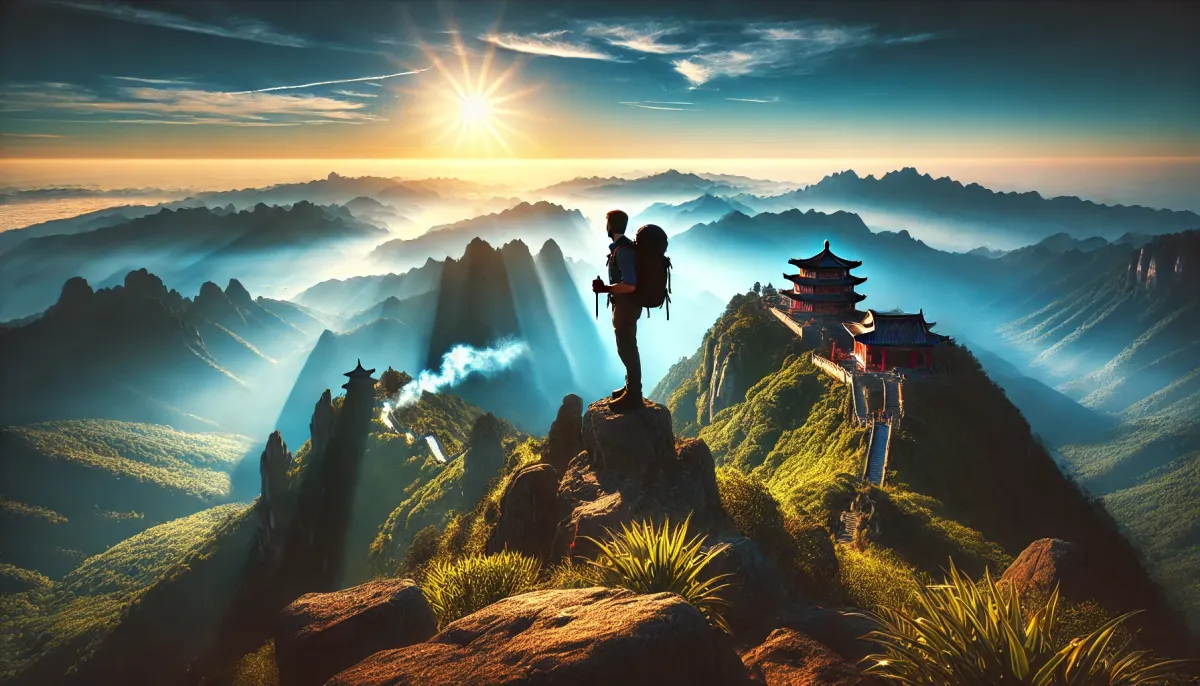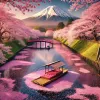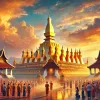Hey fellow adventurers! Mark here, your friendly neighborhood American backpacker, back with another thrilling tale from my Asian escapades. This time, I’m taking you on a spiritual and physical climb up Mount Hengshan, one of China's Five Great Mountains. Get ready for breathtaking views, fascinating cultural encounters, and maybe a little bit of smoke!
From Train to Temple: The Journey Begins
My journey started in Nanning, Guangxi, at 10:22 PM. I boarded the 08 train, car 12, a hard sleeper compartment. A night on the train, and at 9:18 AM, I arrived in Hengyang, Hunan Province. Little did I know this was just the beginning of my adventure! After arriving, I took a motorbike taxi, the ultimate local transportation experience, to the starting point of my hike. I learned quickly that Hengshan County, where I started, is now part of Nanyue District, Hengyang City.
Hengshan's Mystical Allure: A Mountain of Incense and Faith
My motorbike driver, a wealth of local knowledge, schooled me in the mountain's customs. Apparently, it's all about the incense. I learned the proper way to pray: left hand on top, right hand below, standing and then kneeling, holding the incense high – it's all about the “step-by-step rise” (步步高升). The entire town, from supermarkets to massage parlors, sells incense sticks for offerings. It's more than just a mountain; it’s a living testament to faith.
Before I even started my ascent, I learned that Hengshan receives a staggering six million visitors annually! That's a lot of incense. The local economy thrives on this religious tourism.
The Five Great Mountains: A Quick Overview
Before tackling Mount Hengshan, it's worth understanding its place among China's Five Great Mountains (五嶽). These mountains, representing the five cardinal directions (East, South, West, North, and Center), hold immense cultural and religious significance.
| Mountain | Direction | Significance |
|---|---|---|
| Mount Tai | East | The most revered, symbol of power |
| Mount Hengshan | South | Known for its spiritual aura |
| Mount Hua | West | Famous for its treacherous paths |
| Mount Hengshan | North | Often associated with the Taoist tradition |
| Mount Song | Center | A pivotal point of balance |
Today, I conquered the South! Mount Hengshan is known for its gentler slopes and mild climate, aptly nicknamed the “solitary beauty of the South” (南嶽獨秀).
The Ascent: From 100 Meters to 1300 Meters
Starting at around 100 meters above sea level, I began my ascent to the 1300-meter summit of Zhuruong Peak (祝融峰). That's a 1200-meter elevation gain over 14 kilometers – a challenging but rewarding hike, taking about 4-5 hours!
The trail was lined with vendors selling hiking sticks (2-5 Yuan each) and, of course, more incense. I even found myself at the Nanyue Grand Temple (南嶽大廟), a major Taoist temple and a site of imperial worship for centuries.
The initial part of the hike was a bit chaotic, due to road construction and rerouting. But the scenic beauty made up for the inconvenience.
Tickets and Transportation: Planning Your Hengshan Adventure
I purchased my tickets at the Nanyue Hengshan Global Tourism Service Center (南嶽衡山全局旅遊服務中心). A round-trip shuttle bus and park entrance cost me 192 Yuan, including a 4 Yuan insurance fee. You can use your ID card for a quick, self-service ticket purchase.
Encountering Local Culture: The Significance of Incense
Many pilgrims come to Mount Hengshan not just for the scenery but for the spiritual experience. They bring large bags of offerings and incense. I spoke with a pilgrim carrying an impressive amount of incense, underlining the significance of this practice. He explained that many offerings are personally made and brought by the devout.
The Ride Up: A Twisting Journey
The shuttle bus ride up the mountain was…an experience. The winding mountain road gave me quite a headache! Thankfully, this didn't deter my adventurous spirit.
A Chat with a Local Guide: Balancing Taoism and Buddhism
A park interpreter shared insights into Hengshan's unique blend of Taoism and Buddhism, with monks and Taoist priests residing within the same temples – a rarity in China. He explained the August tradition of villagers making pilgrimages to celebrate the birthday of Zhuruong, the fire god, which lent its name to the summit peak, Zhuruongfeng.
The Incense Business: A Thriving Local Economy
The local guide also highlighted the town's unique economy heavily reliant on the incense trade. Nearly every shop sells incense for offerings, creating a unique atmosphere of spirituality and commerce.
The Final Ascent and the Summit: Zhuruong Peak
From Nantian Gate (南天門), a 40-minute hike led me to the summit. Vendors along the way sold high-priced incense (initially 10 Yuan, bargained down to 5 Yuan a box), highlighting the commercial aspect intertwined with the religious experience.
The summit views were absolutely stunning! The panorama of the rolling hills and Nanyue District was breathtaking.
The summit itself was crowded with pilgrims, burning incense and making offerings. I even found a small stall selling souvenirs and snacks.
I also discovered a little-known fact: the cable car to the summit has been broken for five years! Everyone climbs, including elderly people and children.
At the summit, I learned that the spirit enshrined here, Zhuruong, is considered a God in Taoism, unlike Buddha in Buddhism.
Reflections and Future Adventures
My ascent of Mount Hengshan was a profound experience. It blended physical challenge with spiritual reflection. I learned a lot about the local culture, the religious significance of the mountain, and the importance of incense offerings.
I’ll soon be embarking on a multi-province journey through China, visiting other incredible mountains as part of my "Seeking Mountains" documentary series. Stay tuned for more adventures!
Practical Information for Your Trip
- Getting There: Train to Hengyang, followed by a motorbike taxi or bus to the mountain base.
- Entrance Fee: Around 192 Yuan, including shuttle bus.
- Hiking Time: 4-5 hours to the summit.
- Accommodation: Available at the mountain base and potentially near the summit (check availability).
- Best Time to Visit: Spring or autumn for pleasant weather.







